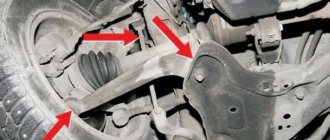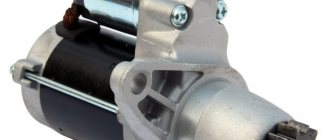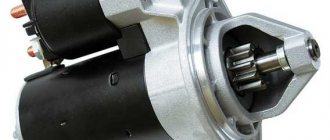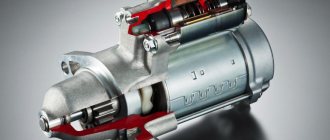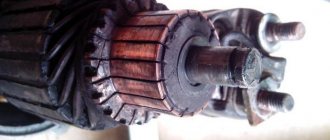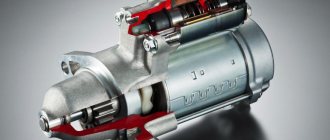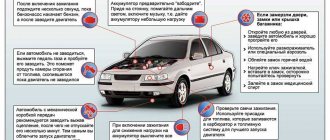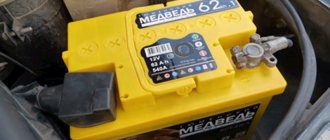More often starter does not turn over when hot due to the fact that when heated, the bushings expand slightly in size, which is why the starter shaft jams or does not rotate at all. Also, the reasons that the starter does not start when hot is the deterioration of electrical contacts in the heat, contamination of its internal cavity, violation of the contact group, and contamination of the “nickels”.
To troubleshoot, you need to get rid of the listed causes. However, there are a couple of “folk” methods with which even a worn starter can be made to rotate under significant heat.
| Cause of failure | What to do |
| Bushing wear | Replace |
| Deterioration of contacts | Clean, tighten, lubricate contacts |
| Reducing the insulation resistance of the stator/rotor winding | Check insulation resistance. Eliminated by replacing the winding |
| Contact plates in the solenoid relay | Clean or replace the “nickels” |
| Dirt and dust in the starter housing | Clean the internal cavity, rotor / stator / contacts / cover |
| Brush wear | Clean the brushes or replace the brush assembly |
Why doesn't the starter turn when it's hot?
The starter test is performed only with a fully charged battery. If the starter cannot crank the engine hot or cranks it very slowly, you may simply have a weak battery.
There may be 5 reasons why the starter does not turn when hot, and almost all of them are typical for cars with high mileage.
Starter bushings
- Reduced bushing clearance . If during the next repair of the starter bushings or bearings with a slightly increased diameter were installed, then when heated, the gaps between the moving parts decrease, which can lead to jamming of the starter shaft. A similar situation occurs when standard bushings wear out. In this case, the rotor warps and begins to touch the permanent magnets.
- Worsening of contacts in the heat . A bad (loose) contact heats up on its own, and if this happens at an elevated temperature, then insufficient current passes through it, or the contact may burn out completely. Often there are problems with the wire from the ignition switch to the starter (oxides) or a bad ground from the battery to the starter. There may also be problems in the ignition switch contact group.
- Reduced winding resistance . As the temperature increases, the resistance value of the stator or rotor winding on the starter can drop significantly, especially when the unit is already old. This can lead to a decrease in electromotive force, and accordingly, the starter will turn poorly or not turn at all.
- "Pyataks" on the solenoid relay . Relevant for VAZ classic cars. In their retractor relay, over time, the so-called “nickels” - closing contacts - burn out significantly. They burn out on their own as they are used, but at high temperatures the quality of contact deteriorates even more.
- Dirty rotor . Over time, the starter armature becomes dirty from brushes and for natural reasons. Accordingly, its electrical contact deteriorates, including the possibility of sticking.
Bendix
It is needed to engage with the flywheel. The Bendix gear and flywheel cannot be in mesh constantly, since the engine crankshaft speed is much higher than what the electric motor is capable of developing. If the Bendix gear constantly rotates at high speeds, the starter will quickly fail.
Bendixes can be divided into three groups by design:
- The roller clutch is the system that is most commonly found. The principle of operation of this system is based on the jamming of the gear relative to its cage at the moment of rotation in one direction and on free running when rotation occurs in the opposite direction.
- The second group is ratchets. This system operates using a ratchet mechanism. Most often, such bendixes can be found on devices from Delco Remy USA. This design is justified, since these starters have more power.
- The third group of equipment is drives in which engagement is carried out by a package of friction plates. This solution is actively used in Bosch starters of the 0001410 series and others intended for trucks.
What to do if the starter does not turn on a hot engine
If the starter cannot crank the engine hot, then you need to dismantle it and check it. The diagnostic algorithm will be as follows:
“Penny” of the retractor relay
- Check the bushings . If the bushings are significantly worn out and play appears, or vice versa, the starter shaft rotates poorly because of them, then the bushings must be replaced. When choosing them, be sure to take into account the size recommended by the manufacturer.
- Inspect electrical contacts . Be sure to check all electrical connections and wires. If there are poor-quality contacts, tighten them and use a cleaner. Particular attention should be paid to the contacts on the “ground”, in the ignition switch and the terminal on the retractor. On VAZs there is often not enough cross-section of the wire from the battery (both mass and positive) or the power cable from the battery to the starter bends.
- Check the stator and rotor windings . This is done using an electronic multimeter switched to ohmmeter mode. It is better to check in different states of the engine, cold, semi-warm and hot, this will allow you to understand how much the insulation resistance value decreases. The critical value is considered to be 3.5...10 kOhm. If it is lower, then you need to change the winding or the starter itself.
- Check the "nickels" . To do this, you need to remove the solenoid relay from the starter and clean them thoroughly. If they are very burnt and cannot be restored, the retractor (or the entire starter) must be replaced. This is a common problem, why the retractor does not work when it is hot.
- Make sure the cover, rotor and outer surface of the starter stator are clean. If they are dirty, they need to be cleaned. To begin with, it makes sense to use an air compressor, and then clean with a brush and, at the final stage, sandpaper (400 or 800).
Since all these procedures require time to remove and disassemble the unit, emergency starting methods will help to get out of the situation and still start a hot engine with such a starter problem as a temporary action.
How to start the engine if the starter does not start when hot
When the starter does not turn hot, but you need to drive, there are a couple of emergency methods for starting the starter. They involve forced closure of the starter contacts directly, bypassing the ignition switch circuit. They will work only in case of problems with the retractor, contacts and slight wear of the bushings; for other reasons, you will have to wait for it to cool down.
Starter terminal location
The first, and most often used, is to close the contacts with a screwdriver or other metal object. With the ignition on, simply close the contacts on the starter housing. The contacts are located on the outside of the starter housing and the wires go to them. You need to close the battery terminal (power wire, +12 Volts) and the starter motor start terminal. You can’t touch the ignition terminal, just as you can’t short-circuit +12 V to the starter housing!
The second method involves preliminary preparation; it is used when the problem is known, but there is no opportunity or desire to deal with it. You can use a two-core cable and a normally open electrical button. Connect two wires at one end of the wire to the starter contacts, then lay the cable in the engine compartment so that its other end comes out somewhere under the “dashboard” to the control panel. Connect the other two ends of the wires to the button. With its help, after turning on the ignition, you can remotely close the starter contacts to start it.
DIY diagnostics and repairs
So, if the engine refuses to start when hot, you need to diagnose the starter unit. We will tell you more about how to check and repair the device below. The starter mechanism is an electric motor that starts working, receiving energy from the battery. One of the main characteristics of this unit is the consumption of high current at the moment of starting the internal combustion engine, but this only happens for a few seconds. And even then, thanks to the ability of the battery not to discharge.
If the unit does not work well when hot, but all units, mechanisms and circuits are operating normally, it is necessary to repair it. This procedure is not a simple one, so you need to have certain skills and knowledge. As a rule, this unit is mounted in the most inconvenient place for the car owner - at the bottom of the engine. For repairs, prepare standard tools, including a set of wrenches. For greater convenience, you will have to use an extended socket wrench (the author of the video about malfunctions, as well as detailed repairs of the device at home, is the Exin Plus channel).
In any case, you first need to dismantle the mechanism; this procedure is individual for each car, so we will not describe it. After the unit is removed, you need to disassemble its structure. If you do not want to encounter assembly problems after repair, then before disassembling the structure, make the appropriate marks on the body.
When disassembling the mechanism, pay attention to the condition of the following elements:
- Nodes and contacts. If you notice that there is a bad contact somewhere, it needs to either be cleaned or replaced. In some cases, stripping can eliminate scorching or oxidation.
- Overrunning clutch or bendix, this component also needs to be carefully checked. Make sure that the component can continue to be used. If the Bendix splines are worn out, then it would be better to change it.
- Anchor. If this component fails, problems with the operation of the motor may occur. The armature is equipped with a commutator, which can burn out as a result of severe wear of the brushes. In addition, no burning of any kind is allowed on the collector, and the same applies to blue plates. At the same stage, the integrity of the windings along with the insulation should be diagnosed.
Also, when this unit is disassembled, it will be necessary to carry out preventive maintenance of all components. All parts without exception must be cleaned of dirt and dust, as this may cause the unit as a whole to malfunction. In the event that the cause of interference in the operation of the mechanism is due to burnt contacts, they must be replaced; if the brushes are worn out or sticking, then you can try to repair them. If the repair does not produce results, then the brush assembly is replaced; for this, you can purchase a special repair kit at any automobile store. In the event that the mechanism simply cannot be repaired, it will need to be replaced with a functional one.
If the need for repairs causes you difficulties, it is better to seek help from specialists. Even if you pay money, you will be confident in the correctness of the actions performed and the functionality of the node.
Loading …
Cause of malfunction
If the starter does not turn over hot, this may be due to various reasons.
When the starter turns tightly, while ensuring poor starting of the power unit, the problem may lie in the following:
- Battery discharge. If the battery has been in use for more than a year, it can discharge quite quickly, especially if the driver forgets to turn off the equipment after parking the car. Therefore, if starting a hot engine causes difficulties, the first thing you should pay attention to is the battery.
- The starter turns poorly when cold or hot as a result of wear on its brushes or bearings. If the brushes wear out, they will not be able to reach the commutator normally, and accordingly, starting the power unit may be difficult. If the bearings wear out, then as a result of heating the armature may come into contact with the stator, which subsequently leads to a short circuit. And this, in turn, reduces the speed of the unit.
- Poor engine starting when hot may be a consequence of incorrect selection of bearing devices as a result of mechanism repair. When bearings get hot, they can seize. The problem can be solved by unraveling and sanding the elements to the required size.
- In some cases, the starter turns poorly when hot due to the ignition switch. In this case, you should initially diagnose the contact group of the device. In order to reduce the likelihood of losses in the electrical circuit of the device, you can additionally install a second relay.
- The retractor relay of the structure has stopped working, this may be indicated by the absence of a click when turning the key in the lock. This element must be replaced, but in addition, it is necessary to diagnose the integrity of the wiring at the solenoid relay terminal. It would be a good idea to visually check the cable between this mechanism and the battery.
- If starting the engine is difficult, but the starter unit is operating normally, the problem may lie in the performance of the power unit. It happens that one of the crankshaft liners gets rubbed as a result of wear, so starting on a cold start is normal, but starting on a hot one is more difficult. This is due to the fact that the liner is clamped by the crankshaft when heated. In some cases, the reason lies in the axial displacement of the shaft itself, which is caused by wear of the axial displacement liners. One way or another, problems of this kind can be solved by repairing the power unit.
Electrical faults
Starter connection diagram
Let's divide possible breakdowns into two parts - those that relate directly to the starter, and those that are related to the supply of voltage to it.
No voltage supply to starter
The reasons for the lack of power supply to the starter may be:
You can read about other car starter malfunctions
- Low battery. Operating the car (including the battery) on short trips, with numerous consumers turned on (headlights, heated steering wheel and seats, heated rear window, etc.) does not help the generator fully restore the battery charge. And the battery itself is perhaps no longer in its first youth. During a cold start, a small force is required to crank the crankshaft since the compression in the cylinders of a cold engine is less, since on a cold engine the gaps between the parts of the connecting rod and piston group are larger. After the engine warms up, the gaps, due to thermal expansion of the parts, decrease, which causes compression (pressure) in the cylinders to increase, and the starter does not turn the hot engine.
- Some cars are characterized by “burning” of the ignition switch contacts when the car does not respond to the ignition key . This “disease” is especially typical for cars that do not have an additional starter relay - it is this that protects the contact group of the ignition switch, preventing excessive sparking of the moving contacts. But, even if such a relay is present, it may also fail. In any case, the starter power circuit can be checked by closing its “positive” contacts with a metal object (screwdriver). If even after this the mechanism does not show “signs of life,” then most likely the starter itself is faulty.
- Be sure to carefully check the power “positive” wire from the battery connected to the solenoid relay. It is quite possible that a poorly tightened terminal on the starter was burnt. Also check the negative wires and their connections to the body and engine.
Malfunction of the starter retractor relay
about direct and reverse battery polarity here
The main reason for the failure of this unit is the failure of contact between the copper “positive” bolts and the contact plate. Over time, carbon deposits appear on their surfaces (due to sparking), disrupting electrical contact. The defect can be eliminated by cleaning or replacing parts, but, unfortunately, the vast majority of solenoid relays have a rolled cover and are therefore practically non-separable. Quite often there is a violation of the contact between the terminal and the wire, as well as “rotting” of this contact.
Crankshaft wear
The reason why the starter does not turn on a hot engine may also be the crankshaft bearings - liners. Due to wear, oil starvation, poor-quality assembly and increased longitudinal (axial) play of the crankshaft, the liners may wear unevenly, which will give them an “wrong” shape, especially as a result of scoring on the surface. As a result, when the engine cools down, gaps appear between the crankshaft bearing journals and the liners, which makes it easier to crank the engine. When it warms up, the presence of these defects, on the contrary, can lead to complete jamming of the engine. In any case, when operating a car, it is advisable to respond as quickly as possible to its seemingly random “whims”.
Various designs
Starters differ in the method of transmitting torque from the electric motor shaft to the bendix. Here you can highlight the classic direct-flow starter, a photo of which is presented in the article. Here the bendix is located directly on the armature shaft. There are also gear starters. Their peculiarity is that there is a gear transmission between the bendix and the motor. These devices are better than direct-flow devices in that, with the same weight and dimensions, they are capable of developing greater torque. More often you can find models with planetary gearboxes. This allows manufacturers not to increase overall dimensions. The planetary gearbox in low-power starters consists of plastic parts. This slightly reduces the resource. However, designs with planetary gearboxes are relatively inexpensive.
